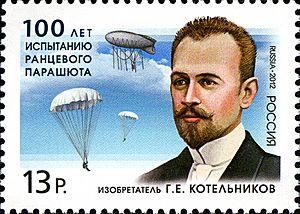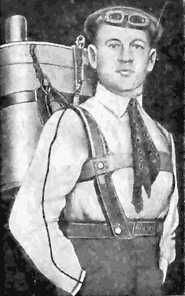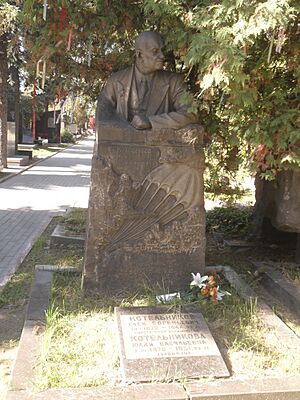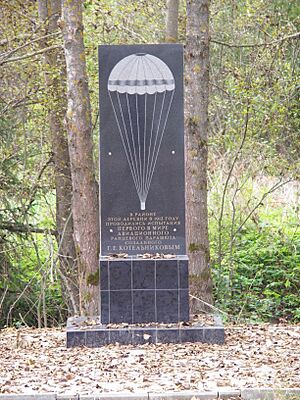Gleb Kotelnikov facts for kids
Quick facts for kids
Gleb Yevgeniyevich Kotelnikov
|
|
|---|---|
 |
|
| Born | 18 January 1872 Saint Petersburg, Russian Empire (now Russia) |
| Died | 22 November 1944 (aged 72) Moscow Region, USSR |
| Rank | Air Force of the USSR, Major-General |
Gleb Yevgeniyevich Kotelnikov (born January 18, 1872 – died November 22, 1944) was a brilliant Russian and Soviet inventor. He is famous for creating the first knapsack parachute. This special parachute could be worn like a backpack. He also invented the braking parachute, which helps slow things down.
Contents
Early Life and Hobbies
Gleb Kotelnikov was born on January 18, 1872. His father was a professor who taught about machines and advanced math. Gleb's parents loved the theater, and this passion rubbed off on him.
From a young age, Gleb enjoyed singing and playing the violin. He also loved to build things. He spent hours making different toys and models.
He finished school at the Kiev Military School in 1894. After serving in the military for three years, he became a reserve officer. He worked as a tax official in different areas. He also helped start drama clubs and sometimes acted in plays. Even then, he kept working on his inventions.
In 1910, Gleb moved back to St. Petersburg. There, he became an actor in a theater group. He used the stage name Glebov-Kotelnikov.
Inventing the Parachute

In 1911, Gleb Kotelnikov saw a terrible accident. A talented Russian pilot named Lev Matsivich died. This event deeply affected Gleb. He became determined to create a safer way for pilots to escape crashing planes.
He spent several years working on his idea. He also used all his personal savings to develop his invention.
The RK-1 Parachute
In 1911, Gleb applied for a patent in France. A patent protects an invention and gives the inventor rights to it. He received patent number 438612 for his design.
He called his invention the RK-1 parachute. RK-1 stands for "Rantseviy Kotelnikova," meaning "Kotelnikov's Knapsack." It was the first model.
Here's how his parachute worked:
- A pilot wore it like a backpack.
- If there was an emergency, the pilot could pull a cord.
- This cord would open the parachute's container.
- The parachute would then open, allowing the pilot to float safely to the ground.
Gleb also designed it to work automatically. If a pilot fell unexpectedly, a cord connected to the plane would open the parachute. This would happen as the pilot's weight pulled the cord.
Testing and Improvements
The RK-1 parachute was successfully used in 1914 during World War I. This showed how important his invention was.
Gleb kept making his parachute better. He created new models, like the RK-2. This version had a softer backpack. He also made the RK-3 and parachutes for carrying cargo. The Soviet Air Force later used many of his designs.
The Braking Parachute
In 1912, Gleb Kotelnikov showed another amazing invention. He demonstrated the "braking parachute" near Tsarskoye Selo. He attached a parachute to the back of a fast car called a Russo-Balt. When the parachute opened, it quickly slowed the car down. This was the first time a braking parachute was used.
In aviation, braking parachutes were first used in 1937. Soviet airplanes used them in the Arctic. These planes were helping famous polar expeditions. The braking parachute allowed planes to land safely on smaller pieces of ice-floes.
Later Contributions and Legacy
Gleb Kotelnikov remained a very important person in parachute development. He helped parachuting grow in the Soviet Union.
In 1924, he changed the parachute design. Instead of a hard container, he used a soft fabric pack. This made parachutes even more practical.
He also created some of the first parachutes for carrying supplies. In 1930, the sport of parachuting began in Russia. The Soviet Airborne Troops were also created that year. This was the first group of paratroopers in history. Gleb's work was key to these developments.
In his later years, Gleb Kotelnikov wrote a book. It was about how parachutes were invented and how they developed over time.
Gleb Kotelnikov passed away on November 22, 1944, during World War II. The village where he first tested his parachute was renamed Kotelnikovo in his honor. His grave is in the Novodevichy Cemetery in Moscow. It has become a special place for Russian paratroopers to visit.



